性别与文学概论参考书目(理论部分)
- 格式:doc
- 大小:48.00 KB
- 文档页数:1
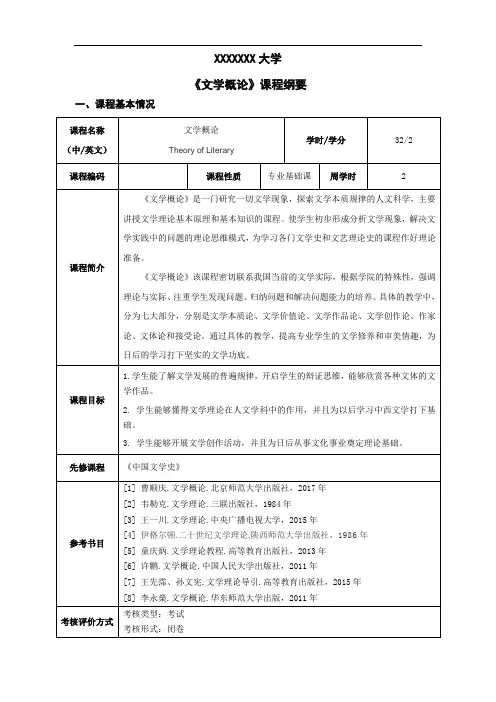

Gender and SexualitySince the late 1980s, theories of Gender and Sexuality have redefinedhow we think about culture and society. They have raised new questionsabout the construction of the gendered and sexualized subject and putforward radical new ideas about PERFORMANCE and PERFORMATIVITY as the means by which the body becomes a SIGNIFYING SYSTEM within SOCIAL FORMATIONS. At the foundation of most theories of Gender and Sexuality is a thoroughgoing critique of the SUBJECT and SUBJECTIVITY. As a social and political category, the subject cuts across all disciplinaryand theoretical boundaries. Being a subject can mean many things – acitizen of a particular community, an AUTONOMOUS being in possessionof a sense of personal wholeness and unity, the subject of an oppressiveruler or of a discourse. Being a subject and possessing subjectivity arenot the birthrights of all human beings, however; they are specialized attributes, more or less unique to Western or Westernized cultures. Thisnotion of the modern subject begins in the Enlightenment, with the reflections of John Locke, who regarded personal identity as unique, sovereign, and autonomous. Subjectivity, the consciousness of one’s his- torical and social agency, was the prerogative of the Western individualwho defined himself in opposition to the OTHER, to that which was nota subject and did not possess subjectivity. The classic philosophical expression of this relationship of the subject to what is not the subject is Hegel’s dialectic of the master and slave. As is so often the case in Enlightenment thought, the potential for subversion and AMBIV ALENCEis contained in what appears to be a universal concept. For Hegel’s dia-lectic also suggests the possibility of the disenfranchised slave or non-subject acquiring subjectivity by overpowering the master. By the endof the nineteenth century, Friedrich Nietzsche could speak of the “subjectas multiplicity,” and by the 1920s, Freud would call into question mostof our preconceived notions about of selfhood and sexual identity.Closely linked to the concept of the subject is the concept of IDENTITY, which is typically used to cover the process by which a subject becomesa particular kind of subject. Rather than a fixed quality or ESSENCE, iden-tity is understood by theorists of Gender and Sexuality as an ongoingprocess of construction, performance, appropriation, or mimicry. This perspective, strongly influenced by Michel Foucault’s theories of sexual-103ity, came be known as SOCIAL CONSTRUCTIONISM, the idea that subjectiv- ity and identity are not natural categories or essential features of human existence, unique and indivisible aspects of one’s being; they are ratherthe material effects of the discourses and images that surround us. Thecrucial questions raised by theories of Gender and Sexuality have to dowith agency and determination: Who or what determines the construc-tion of gender and sexuality? How is social AGENCY acquired and main- tained by these constructions? Is one constructed solely by social ideologies and institutions? Or do individuals have the freedom toact reflexively, to engage in what Anthony Giddens calls “projects ofthe self ”? For Foucault, sexuality has played a fundamental role in developing modern modes of social organization and regulation. In his landmark study, History of Sexuality (1976), Foucault argues that sexual- ity, far from being proscribed or repressed in the nineteenth century, became part of a discourse that sought to identify and regulate all forms of sexua l behavior. “Instead of a massive censorship,” he claimed, “what was involved was a regulated and polymorphous incitement to dis- course” (34). Religious confession, Psychoanalysis, sexology, literature–all were instrumental in this incitement, which simultaneously made sexuality a public matter and a target of social administration. “Underthe authority of a language that had been carefully expurgated so thatit was no longer directly named, sex was taken charge of, trackeddown as it were, by a discourse that aimed to allow it no obscurity, no respite” (20).Foucault’s critique of sexuality brilliantly exposed the ideological mechanisms by which sexual identities are maintained and regulated by institutional authorities. In this regard, his work paralleled that of Louis Althusser whose theory of IDEOLOGY held that the subject is always already “interpellated,” coercively recruited by ideological apparatusesof the State. (On Althusser, see pp. 112–13.) Subjectivity, selfhood, and citizenship are the products of socialization; agency, that quantum ofwill that enables the subject to move within social spheres, is a productof those very spheres. In another direction, Giddens argues that the individual has many significant opportunities to intervene in the ideo- logical construction of subjectivity; she is able to choose from an arrayof available discursive strategies and write the narrative of herself. These techniques of self-development guarantee freedom even in contexts of overwhelming social power. In his later work, Foucault recognized that 104the individual possessed a necessary freedom from POWER, which is “exercised only over free subjects . . . and only insofar as they are free. By this we mean individual or collective subjects who are faced with a field of possibilities in which several ways of behaving, several reactions and diverse comportments may be realized” (“Subject” 221).Judith Butler is perhaps the most influential theorist to explore theidea of sexual and gender identity as a social PERFORMANCE, a site of power and discourse. “To what extent,” she asks, “do regulatory practices of gender formation and division constitute identity, the internal coher- ence of the subject, indeed, the self-identical status of the person?”(Gender Trouble 16). As an alternative to such naturalized regulatorypractices, she developed a model of PERFORMATIVITY, which she distin- guished from a normative model of PERFORMANCE:[performance] presumes a subject, but [performativity] contests the very notion of the subject. . . . What I’m trying to do is think about performa-tivity as that aspect of discourse that has the capacity to produce what it names. Then I take a further step, through the Derridean rewriting of [ J. L.] Austin, and suggest that this production actually always happens througha certain kind of repetition and recitation. So if you want the ontology of this, I guess performativity is the vehicle through which ontologicaleffects are established. Performativity is the discursive mode by whichont ological effects are installed. (“Gender” 111–12)According to Butler, gender and sexual identity (self-consciousness aboutthe ontology or “being” of the self) has always been a matter of perfor- mance, acquiescence to social norms and to mystifications about sexual-ity and gender derived from philosophy, religion, psychology, medicine,and popular culture. Performativity upsets these norms, sometimes appropriating them in a transformed fashion, at other times parodyingor miming them in a way that draws out their salient elements for criti- cism. The “ontological effects” to which Butler refers are all that we cansee or know of “true” gender or sexual identity, a situation dramatizedmost clearly in drag and other forms of transvestism. For while the drag queen prides himself on getting every detail right and being true to a particular vision of femininity, his performance is in the end a critiqueof the very category of woman he strives to imitate faithfully. These reflections on the ontology of sexual identity have led Butler and othersto argue that the so-called biological notion of “sex” may itself not be105free from a performative dimension. Performativity, as a mode of subject-and identity-formation, is clearly indebted to poststructuralist notions of language and TEXTUALITY premised on the idea of the subject as the subject of a discourse. It is the quintessential expression of personal agencyin a context of late MODERNITY, a context in which naturalistic, biologi- cal, or ESSENTIALIST conceptions of the subject and of gender and sexual identity are no longer operative. Performativity is, paradoxically, the provisional result of a process of construction and the material sign ofan authentic self. Butler’s later work, especially Excitable Speech: A Politics of the Performative (1997), indicates the decisive role that public language–her chief example is “hate speech” – plays in constituting the performa- tive element of social life.Innovations in queer theory have made it evident that performativityis a function of the choices that gay and lesbian individuals make everyday and in all walks of life. To a certain extent, such individuals havealways known that the performative is the real. This is why, as AlanSinfield argues in The Wilde Centur y (1994), Oscar Wilde’s life experienceis as valuable for queer theory as his literary works, for it posits perfor- mativity at the foundation of queer identity.Queer theory seeks, among other things, to describe or map out theways homosexual or homoerotic desire manifests itself in literary and cultural texts. It is strongly reliant on psychoanalytic categories and concepts, but seeks to overcome the heterosexual limits of psychoana-lytic theory. Teresa de Lauretis, who was one of the first to use theterm queer theory, has since rejected it because of its appropriation by mainstream media. Certainly popular television shows like Queer Eye for the Straight Guy have made the word “queer,” which had been appropri- ated by the gay and lesbian movement as a symbol of political empower- ment, into a sanitized label for homosexuals with no political agenda. Others feel that queer theory privileges gay male experience at the expense of lesbian and bisexual experience. To some degree, the malebias is due to the strong influence of gay male theorists. It is also due tothe enormous influence of Eve Kosofsky Sedgwick’s Between Men (1985), which, along with Foucault’s History of Sexuality, provided the theoretical scaffolding for academic queer theory. One of her most powerful formu- lations, the concept of homosociality, has come to enjoy rather widespread use across academic disciplines. HOMOSOCIAL DESIRE is grounded in René Girard’s theory of “triangular desire” and in Gayle Rubin’s theory106of the “sex/gender system,” specifically her critique of Lévi-Strauss’s analysis of kinship systems in which women function as gifts in eco-nomic exchanges between men. According to Sedgwick, homosocialdesire between men is expressed in a triangular structure with a woman(or a “discourse” of “woman”) standing as a putative object of at leastone of them: “the ultimate function of women is to be conduits of homo- social desire” (99). These relationships need not be sexual; in fact theyare far more potent whenever the sexual element is sublimated in the MIMICRY of a heterosexual identity that effectively disguises homosexual “deviancy.” Homosocial structures frequently elicit homophobia as an institutionalized check on repressed homosexual desire, but they moreoften lead to “changes in men’s experience of living within the shifting terms of compulsory heterosexuality” (134). Her chapter on HenryJames in her Epistemology of the Closet (1990) illustrates the divide between homosocial networking, which confirms the heterosexual status quo,and “homosexual panic,” which reacts violently against any manifesta-tion of eroticism or “genitalized” behavior that might emerge out of such networks.Queer theory has come to encompass a substantial body of work inlesbian studies. Moniqu e Wittig’s Lesbian Body attacks the tradition of anatomy based on the orderly and ordered male body and offers insteadthe lesbian body as a model of the desiring subject. Like other feministswho challenge the authority of PATRIARCHAL discourse, Wittig openly confronts the problem of the SUBJECT POSITION she occupies as a theorist and writer; she disrupts the texture of her writing and thus repeats atthe level of her discourse the disorderly nature of the lesbian body itself. Adrienne Rich, in her much-an thologized essay, “Compulsory Hetero- sexuality and the Lesbian Existence,” attacks “heterocentricity” as acovert mode of socialization that seeks willfully to repress the “enor-mous potential counterforce” (39) of lesbian experience. Because hetero- sexuality is the compulsory cultural norm, the oppression of women–their sexual slavery – is more difficult to name. Rich revalues the so-called perversity of lesbian desire, more frightening even than male homosexuality, and posits a “lesbian continuum” f ree of invidious binarysexual typologies. Lesbian Feminism is not concerned with hating menbut rather with celebrating the life choices of women who love women.It is not that heterosexuality is in and of itself oppressive, it is that “theabsence of cho ice remains the great unacknowledged reality” (67).107Acknowledging this reality and creating and preserving choice is what motivates the successors of Rich and Wittig. Thus Theresa de Lauretis,in The Practice of Love: Lesbian Sexuality and Perverse Desire (1994), chal- lenges psychoanalytical theories of normative sexuality that would limitsuch choices, and Lynda Hart, Fatal Women: Lesbian Sexuality and theMark of Aggression (1994), attacks the pathologization and appropriationof lesbian sexuality by the “male Imaginary” and defends women whorespond criminally to men who attempt to foreclose lesbian desire.In both cases free choice is celebrated, for without it there can be nochance for free subjects to combat the fortified positions of social andcultural power.Note. For more on issues related to gender and sexuality, see Femi-nism, Ethnic Studies, and Postcolonial Studies.WORKS CITEDButler, Judith. “Gender as Performance.” Interview. In A Critical Sense: Interviews with Intellectuals. Ed. Peter Osborne. London: Routledge, 1996.108–25.——. Gender Trouble: Feminism and the Subversion of Identity. New York: Rout- ledge, 1990.Foucault, Michel. The History of Sexuality. 1976. V ol. 1. Trans. Robert Hurley. New York: Pantheon Books, 1978.——. “The Subject and Power.” In Michel Foucault: Beyond Structuralism and Hermeneutics. Eds. Herbert L. Dreyfus and Paul Rabinow. Chicago: Univer-sity of Chicago Press, 1984. 208–26.Sedgwick, Eve Kosofsky. Between Men: English Literature and Male Homosocial Desire. New York: Columbia University Press, 1985.Rich, Adrienne. “Compulsory Heterosexuality and the Lesbian Existence.” InBlood, Bread and Poetry: Selected Prose 1979–1985. New York: Norton, 1986. 23–75.119/352。
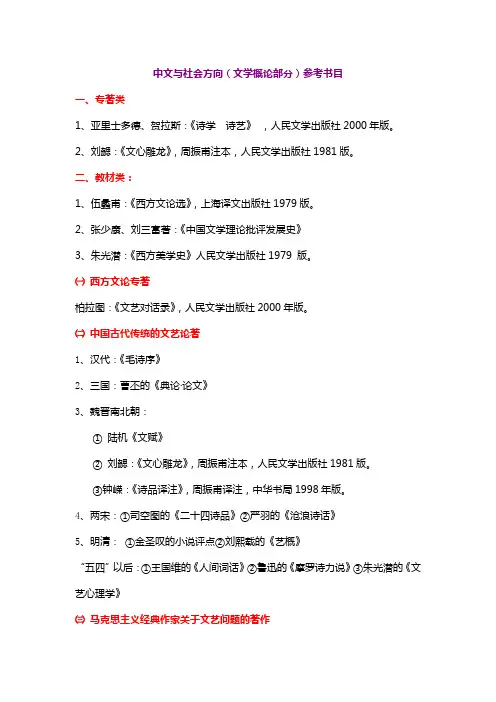
中文与社会方向(文学概论部分)参考书目
一、专著类
1、亚里士多德、贺拉斯:《诗学诗艺》,人民文学出版社2000年版。
2、刘勰:《文心雕龙》,周振甫注本,人民文学出版社1981版。
二、教材类:
1、伍蠡甫:《西方文论选》,上海译文出版社1979版。
2、张少康、刘三富著:《中国文学理论批评发展史》
3、朱光潜:《西方美学史》人民文学出版社1979 版。
㈠西方文论专著
柏拉图:《文艺对话录》,人民文学出版社2000年版。
㈡中国古代传统的文艺论著
1、汉代:《毛诗序》
2、三国:曹丕的《典论〃论文》
3、魏晋南北朝:
①陆机《文赋》
②刘勰:《文心雕龙》,周振甫注本,人民文学出版社1981版。
③钟嵘:《诗品译注》,周振甫译注,中华书局1998年版。
4、两宋:①司空图的《二十四诗品》②严羽的《沧浪诗话》
5、明清:①金圣叹的小说评点②刘熙载的《艺概》
“五四”以后:①王国维的《人间词话》②鲁迅的《摩罗诗力说》③朱光潜的《文艺心理学》
㈢马克思主义经典作家关于文艺问题的著作
1、傅腾霄主编:《马列文论选注》,社会科学文献出版社1999年版。
2、毛泽东《在延安文艺座谈会上的讲话》。
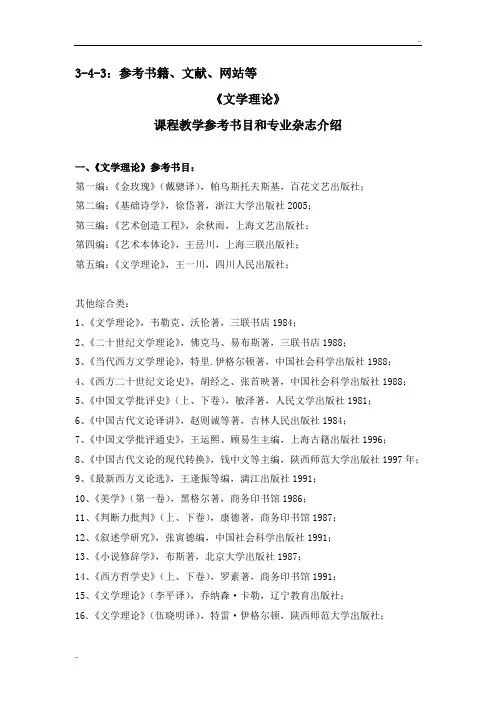
3-4-3:参考书籍、文献、网站等《文学理论》课程教学参考书目和专业杂志介绍一、《文学理论》参考书目:第一编:《金玫瑰》(戴骢译),帕乌斯托夫斯基,百花文艺出版社;第二编:《基础诗学》,徐岱著,浙江大学出版社2005;第三编:《艺术创造工程》,余秋雨,上海文艺出版社;第四编:《艺术本体论》,王岳川,上海三联出版社;第五编:《文学理论》,王一川,四川人民出版社;其他综合类:1、《文学理论》,韦勒克、沃伦著,三联书店1984;2、《二十世纪文学理论》,佛克马、易布斯著,三联书店1988;3、《当代西方文学理论》,特里.伊格尔顿著,中国社会科学出版社1988;4、《西方二十世纪文论史》,胡经之、张首映著,中国社会科学出版社1988;5、《中国文学批评史》(上、下卷),敏泽著,人民文学出版社1981;6、《中国古代文论译讲》,赵则诚等著,吉林人民出版社1984;7、《中国文学批评通史》,王运熙、顾易生主编,上海古籍出版社1996;8、《中国古代文论的现代转换》,钱中文等主编,陕西师范大学出版社1997年;9、《最新西方文论选》,王逢振等编,漓江出版社1991;10、《美学》(第一卷),黑格尔著,商务印书馆1986;11、《判断力批判》(上、下卷),康德著,商务印书馆1987;12、《叙述学研究》,张寅德编,中国社会科学出版社1991;13、《小说修辞学》,布斯著,北京大学出版社1987;14、《西方哲学史》(上、下卷),罗素著,商务印书馆1991;15、《文学理论》(李平译),乔纳森·卡勒,辽宁教育出版社;16.《文学理论》(伍晓明译),特雷·伊格尔顿,陕西师范大学出版社;17.《追忆》(郑学勤译),宇文所安,上海古籍出版社;三联出版社;18.《中国文论》,宇文所安,上海社会科学出版社;19.《沉重的肉身》,刘小枫,上海人民出版社,华夏出版社;20.《我能否相信自己》,余华,人民日报出版社;21.《谈艺录》,钱钟书,中华书局。
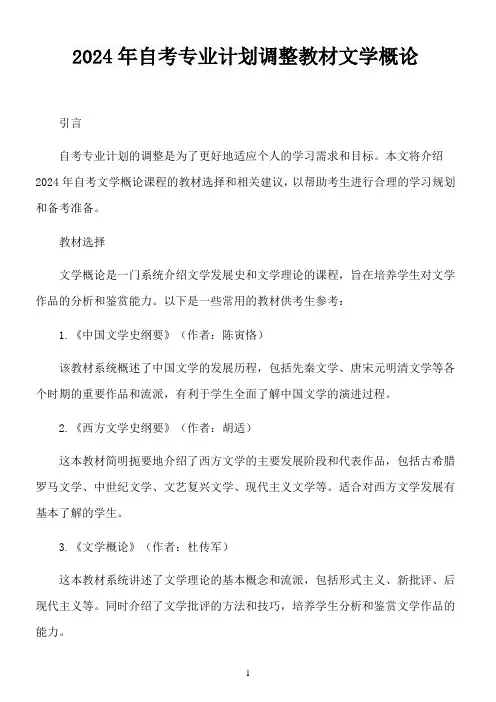
2024年自考专业计划调整教材文学概论引言自考专业计划的调整是为了更好地适应个人的学习需求和目标。
本文将介绍2024年自考文学概论课程的教材选择和相关建议,以帮助考生进行合理的学习规划和备考准备。
教材选择文学概论是一门系统介绍文学发展史和文学理论的课程,旨在培养学生对文学作品的分析和鉴赏能力。
以下是一些常用的教材供考生参考:1.《中国文学史纲要》(作者:陈寅恪)该教材系统概述了中国文学的发展历程,包括先秦文学、唐宋元明清文学等各个时期的重要作品和流派,有利于学生全面了解中国文学的演进过程。
2.《西方文学史纲要》(作者:胡适)这本教材简明扼要地介绍了西方文学的主要发展阶段和代表作品,包括古希腊罗马文学、中世纪文学、文艺复兴文学、现代主义文学等。
适合对西方文学发展有基本了解的学生。
3.《文学概论》(作者:杜传军)这本教材系统讲述了文学理论的基本概念和流派,包括形式主义、新批评、后现代主义等。
同时介绍了文学批评的方法和技巧,培养学生分析和鉴赏文学作品的能力。
备考建议1.熟悉教材内容:认真阅读所选教材,理解其中的重要观点和理论,掌握文学发展史和文学理论的核心知识。
2.扩展阅读:除了教材,考生还可以阅读相关的文学作品、评论和研究资料,拓宽自己的文学视野和知识面。
3.做笔记总结:在学习过程中,及时做好笔记和总结,整理出重要的概念和观点,方便日后复习和回顾。
4.制定学习计划:根据自身的时间安排和学习进度,制定合理的学习计划,保证每个章节都有足够的时间进行深入学习和思考。
5.划重点和重点突破:根据考试大纲,划出重点内容,并加强对这些内容的学习和理解。
同时,关注一些常考的题目类型和解题技巧,进行有针对性的突破。
6.多做练习题:通过做题,巩固所学知识,培养解题思路和分析能力。
可以找一些历年真题或模拟题进行练习,提高应试能力。
总结在2024年自考文学概论课程的教材选择和备考建议中,考生应选择合适的教材,全面了解中国文学和西方文学的发展史,并掌握相关的文学理论和批评方法。
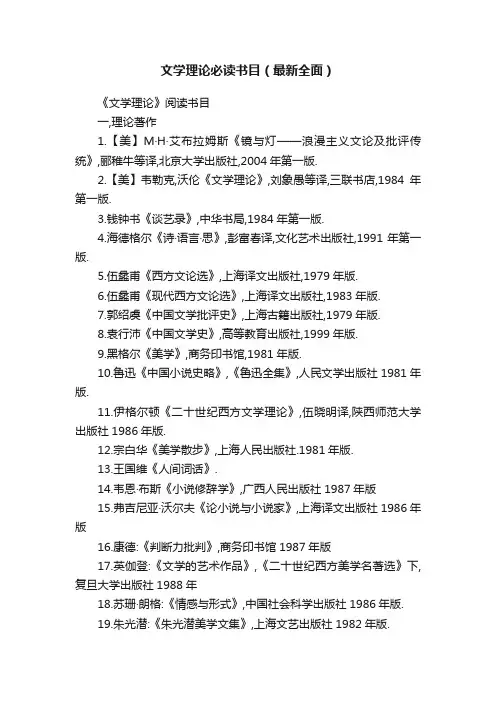
文学理论必读书目(最新全面)《文学理论》阅读书目一,理论著作1.【美】M·H·艾布拉姆斯《镜与灯——浪漫主义文论及批评传统》,郦稚牛等译,北京大学出版社,2004年第一版.2.【美】韦勒克,沃伦《文学理论》,刘象愚等译,三联书店,1984年第一版.3.钱钟书《谈艺录》,中华书局,1984年第一版.4.海德格尔《诗·语言·思》,彭富春译,文化艺术出版社,1991年第一版.5.伍蠡甫《西方文论选》,上海译文出版社,1979年版.6.伍蠡甫《现代西方文论选》,上海译文出版社,1983年版.7.郭绍虞《中国文学批评史》,上海古籍出版社,1979年版.8.袁行沛《中国文学史》,高等教育出版社,1999年版.9.黑格尔《美学》,商务印书馆,1981年版.10.鲁迅《中国小说史略》,《鲁迅全集》,人民文学出版社1981年版.11.伊格尔顿《二十世纪西方文学理论》,伍晓明译,陕西师范大学出版社1986年版.12.宗白华《美学散步》,上海人民出版社.1981年版.13.王国维《人间词话》.14.韦恩·布斯《小说修辞学》,广西人民出版社1987年版15.弗吉尼亚·沃尔夫《论小说与小说家》,上海译文出版社1986年版16.康德:《判断力批判》,商务印书馆1987年版17.英伽登:《文学的艺术作品》,《二十世纪西方美学名著选》下,复旦大学出版社1988年18.苏珊·朗格:《情感与形式》,中国社会科学出版社1986年版.19.朱光潜:《朱光潜美学文集》,上海文艺出版社1982年版.20.索绪尔:《普通语言学教程》,商务印书馆1980年版.21.佛斯特:《小说面面观》,花城出版社1981年版.22.高尔基:《论文学》,人民文学出版社1978年版.23.亚里士多德:《诗学》,人民文学出版社1962年版.24.《文心雕龙》(梁·刘勰)二,精品教材1.童庆炳主编《文学理论教程》高等教育出版社1998年版2.刘安海,孙文宪主编《文学理论》,武汉华中师大出版社1999年版3.王耀辉《文学文本解读》武汉华中师大出版社1999年版4.王先沛主编《文学批评原理》武汉华中师大出版社1999年版三,专业刊物1.文学评论2.文艺理论研究3.当代作家评论4.人大复印资料·文艺理论。

《文学概论》参考书目1、参考教材《文学理论教程》童庆炳主编高等教育出版社1998年版《文学理论》鲁枢元等主编华东师范大学出版社2006年版《文学原理新释》顾祖钊著人民文学出版社2000年版《文学原理》王元骧著广西师范大学出版社2002年版2、参考书目《辞海·文学分册》上海辞书出版社《辞海·艺术分册》上海辞书出版社《文学词典》湖北人民出版社《简明中国古典文学词典》江西人民出版社《简明外国文学词典》北京出版社《文学理论学习参考资料》北京师范大学出版社《中国古代文艺理论词典》吉林文史出版社《西方文学理论大词典》吉林文史出版社《中国的文学理论》(美)刘若愚著中州古籍出版社《文学理论》(美)韦勒克、沃伦著三联书店《美的历程》李泽厚著文物出版社《美学散步》宗白华著北京大学出版社《谈艺录》钱钟书著三联书店《中国美学史大纲》叶郎著北京大学出版社《中国艺术精神》徐复观著春风文艺出版社《中国文学精神》徐复观著上海书店出版社《中国文学理论发展史》张少康著北京大学出版社《中国诗学》叶维廉著三联书店《中国文学批评史略》滕福海著吉林人民出版社2002年《西方文论选》伍蠡甫主编上海译文出版社《西方美学史》朱光潜著上海文艺出版社《当代西方文艺理论》朱立元著华东师范大学出版社《外国文学评论选》湖南人民出版社《诗学》亚里士多德著商务印书馆《诗艺》贺拉斯著人民文学出版社《拉奥孔》莱辛著人民文学出版社《汉堡剧评》莱辛著人民文学出版社《歌德谈话录》人民文学出版社《美育书简》席勒著中国文联出版公司《美学》黑格尔著商务印书馆《判断力批判》康德著商务印书馆《艺术哲学》丹纳著商务印书馆《十九世纪文学主潮》勃兰兑斯著《发生认识论原理》(瑞士)皮亚杰著商务印书馆《艺术的起源》(德)格罗塞著商务印书馆《罗丹艺术论》葛赛尔著人民日报出版社2000版《法国作家论文学》三联书店《十九世纪英国文论选》人民文学出版社《别林斯基选集》(一、二、三卷)上海译文出版社《车尔尼雪夫斯基论文学》(上、中、下卷)上海译文出版社《杜勃罗留波夫选集》(第一、二卷)上海译文出版社《普列汉诺夫美学论文集》(Ⅰ.Ⅱ集)人民出版社《论文学》高尔基著人民出版社《契珂夫手记》浙江人民出版社1982年版《现代西方文论选》伍蠡甫主编上海译文出版社1983年版《二十世纪西方现代文论述评》张隆溪三联出版社《精神分析引论》弗洛伊德著商务印书馆《艺术与视知觉》阿思海姆中国社会科学出版社1984年《美感》(美)乔治.桑塔耶纳著中国社会科学出版社《艺术问题》(美)苏珊.朗格著中国社会科学出版社《艺术即经验》(美)约翰.杜威著中国社会科学出版社《符号学美学》(法)R.巴特著辽宁文艺出版社《接受美学与接受理论》(德)姚斯.(美)霍拉勃辽宁文艺出版社《存在主义美学》(日)今道友信著辽宁文艺出版社《真理与方法》(德)H.G伽达默尔著辽宁文艺出版社《抽象与移情》(德)W.沃林格著辽宁文艺出版社《人的潜能和价值》(美)马斯洛著华夏出版社《第三思潮:马斯洛心理学》(英)弗兰克.戈布尔著上海译文出版社《结构主义和符号学》(英)特伦斯.霍克斯著上海文艺出版社《读者反应批评:理论与实践》(美)斯坦利.费什著中国社会科学出版社《作品.文学史与读者》(德)瑙曼著文化艺术出版社《艺术》(英)克莱夫.贝尔著中国文联出版公司《走向科学的美学》(美)托马斯.门罗著中国文联出版公司《小说修辞学》(美)韦思.布斯著广西人民出版社《现代小说美学》(美)利昂.塞米利安著陕西人民出版社《小说面面观》(英)佛斯特花城出版社《当说者被说的时候》比较叙述学导论赵毅衡著中国人民大学出版社《艺术形态学》(苏)列.谢.维戈茨基著上海文艺出版社《艺术类型学》李心峰主编文化艺术出版社《艺术心理学》(苏)莫.卡冈著三联书店《艺术社会学》(匈)阿诺德.豪泽尔著学林出版社《艺术与宗教》(苏)乌格里诺维奇著三联出版社《艺术与科学》(苏)米.贝京著文化艺术出版社《文艺伦理学论纲》赵红梅戴茂堂著中国社会科学出版社《法律与文学》苏力著三联书店《文学批评原理》(英)艾.阿.瑞恰慈著百花洲文艺出版社《批评的概念》(美)雷内.韦勒克著中国美术学院出版社《批评的剖析》(美)弗赖著百花洲文艺出版社《比较文学》陈、孙景尧、谢天振主编高等教育出版社《比较诗学》(美)厄尔.迈纳著中央编译出版社《悲剧的诞生—尼采美学文选》三联书店《裸体艺术论》陈醉著文化艺术出版社.。
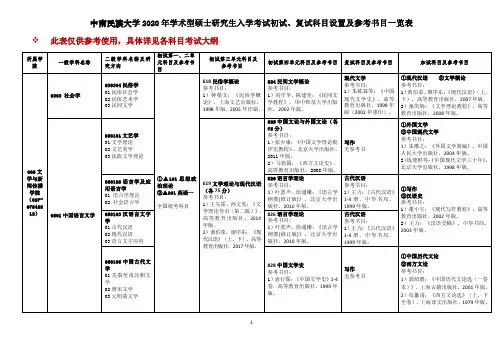
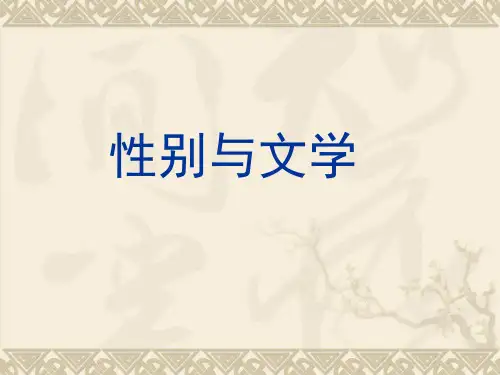

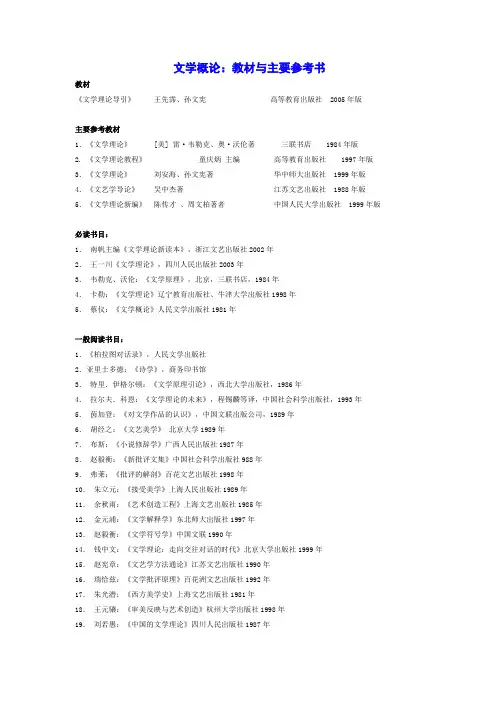
文学概论:教材与主要参考书教材《文学理论导引》王先霈、孙文宪高等教育出版社 2005年版主要参考教材1.《文学理论》 [美] 雷·韦勒克、奥·沃伦著三联书店 1984年版2. 《文学理论教程》童庆炳主编高等教育出版社 1997年版3.《文学理论》刘安海、孙文宪著华中师大出版社 1999年版4.《文艺学导论》吴中杰著江苏文艺出版社 1988年版5.《文学理论新编》陈传才、周文柏著者中国人民大学出版社 1999年版必读书目:1.南帆主编《文学理论新读本》,浙江文艺出版社2002年2.王一川《文学理论》,四川人民出版社2003年3.韦勒克、沃伦:《文学原理》,北京,三联书店,1984年4.卡勒:《文学理论》辽宁教育出版社、牛津大学出版社1998年5.蔡仪:《文学概论》人民文学出版社1981年一般阅读书目:1.《柏拉图对话录》,人民文学出版社2.亚里士多德:《诗学》,商务印书馆3.特里.伊格尔顿:《文学原理引论》,西北大学出版社,1986年4.拉尔夫.科恩:《文学理论的未来》,程锡麟等译,中国社会科学出版社,1993年5.茵加登:《对文学作品的认识》,中国文联出版公司,1989年6.胡经之:《文艺美学》北京大学1989年7.布斯:《小说修辞学》广西人民出版社1987年8.赵毅衡:《新批评文集》中国社会科学出版社988年9.弗莱:《批评的解剖》百花文艺出版社1998年10.朱立元:《接受美学》上海人民出版社1989年11.余秋雨:《艺术创造工程》上海文艺出版社1985年12.金元浦:《文学解释学》东北师大出版社1997年13.赵毅衡:《文学符号学》中国文联1990年14.钱中文:《文学理论:走向交往对话的时代》北京大学出版社1999年15.赵宪章:《文艺学方法通论》江苏文艺出版社1990年16.瑞恰兹:《文学批评原理》百花洲文艺出版社1992年17.朱光潜:《西方美学史》上海文艺出版社1981年18.王元骧:《审美反映与艺术创造》杭州大学出版社1998年19.刘若愚:《中国的文学理论》四川人民出版社1987年20.巴尔:《叙述学:叙事理论导论》中国社会科学出版社1995年21.罗兰巴特:《符号学原理》三联书店1999年22.佛克马:《文学研究和文化参与》北京大学出版社1996年23.佛克马等:《问题与观点:20世纪文学理论综论》百花文艺出版社2000年24.格罗塞:《艺术的起源》商务印书馆1984年25.托多罗夫:《批评的批评》三联书店1988年26.塞尔登:《文学批评理论》北京大学出版社2000年27.黑格尔:《美学》三卷。
《文学概论》参考书目12008.91.吕德申主编:《马克思主义文论选》(上、下),高等教育出版社1992年版年版。
2.《别林斯基选集》,上海译文出版社1979年版o3.《普列汉诺夫美学论文集》,人民出版杜1983年版。
4.童庆炳主编:《现代心理美学》,中国社会科学出版杜1993年版。
5.胡经之、王岳川主编:《文艺学美学方法论》,北京大学出版社1994年版。
6 韦勒克:《批评的诸种概念》,四川文艺出版社1987年版。
7.特伦斯·霍克斯《结构主义和符号学》,上海译文出版杜1987年版。
8.王逢振主编:《新马克思主义》,中国人民大学出版社2004年版。
9 .[英]拉曼·塞尔登编:《文学批评理论——从柏拉图到现在》,刘象愚、•陈永国等译.北京大学出版社2003年版。
10.[德]瑙曼等:《作品、文学史与读者》,文化艺术出版社1997年版。
11.刘勰著,范文澜注:《文心雕龙注》,人民文学出版社1978年版。
12 .钟锺嵘《诗品》、严羽《沧浪涛话》、叶燮《原诗》、王国维《人间词话》。
13 .刘象愚《外国文论简史》北京大学出版社,2006年1月, 572页.14 .杨慧林编著:《西方文论概要》,中国人民大学出版社,2003-07-0115..章安祺编:《西方文艺理论史精读文献》,中国人民大学出版社,199616 .毛泽东:《实践论》,《毛泽东选集》第1卷,人民出版社1991年版。
17 .韦勘克、沃伦:《文学理论》,三联书店1984年版。
18 .莫伊谢依•萨莫伊洛维奇•卡冈:《美学和系统方法》,中国文联出版公司1985年版。
19 .波斯被洛夫:《文学原理》,三联书店1985年版。
20 .郭绍虞:《中国文学批评史》,中华书局1962年版。
《文学概论》分章思考题与拓展阅读书目“绪论”思考题:1、有人说,文学让人暂时忘记现实世界,是一种精神鸦片,应该唾弃。
你认为呢?2、学习文学理论有何意义?3、为什么说学习文学理论要具有问题意识?“绪论”拓展阅读书目:1、【美】韦勒克、沃伦:《文学理论》,刘象愚等译,北京:三联书店1984年版。
2、【美】卡勒:《文学理论》,李平译,沈阳:辽宁教育出版社1998年版3、【英】伊格尔顿:《二十世纪西方文学理论》,伍晓明译,西安:陕西师大出版社1986年版4、【荷】佛克马、易布斯:《二十世纪文学理论》,林书武等译,北京:三联书店1988年版。
5、【美】科恩主编:《文学理论的未来》,程锡麟等译,北京:中国社会科学出版社1993年版6、【英】塞尔登:《文学批评理论——从柏拉图到现在》,刘象愚等译,北京:北京大学出版社2000年版7、南帆主编:《文学理论:新读本》,杭州:浙江文艺出版社2002年版8、王一川:《文学理论》,成都:四川人民出版社2003年版9、陶东风主编:《文学理论基本问题》,北京:北京大学出版社2004年版10、【美)】希利斯・米勒:《文学死了吗》,秦立彦译,桂林:广西师范大学出版社, 2007第一章“文学作为活动”思考题:1、为什么说文学是一种活动?其理论依据何在?2、你认为文学有没有本质?为什么?3、你如何看待反本质主义思潮?第一章拓展阅读书目:1、【美】艾布拉姆斯:《镜与灯——浪漫主义文论及批评传统》,郦稚牛等译,北京:北京大学出版,19892、【美】刘若愚:《中国文学理论》,杜国清译,南京:江苏教育出版社,20063、马克思:《1844年经济学哲学手稿》,北京:人民出版社,19854、【德】海德格尔:《存在与时间》,陈嘉映等译,北京:三联书店,19875、【德】海德格尔:《海德格尔诗学文集》,成穷等译,武汉:华中师范大学出版社,19926、【德】哈贝马斯:《交往行为理论》,曹卫东译,上海:上海人民出版社,20047、傅道彬、于茀:《文学是什么》,北京:北京大学出版社,20028、童庆炳:《文学活动的美学阐释》,西安:陕西人民出版社,1992第二章“文学活动的审美意识形态属性”思考题:1、有没有固定不变的文学概念?为什么?2、如何理解文学的审美意识形态属性?你觉得文学是一种审美意识形态吗?为什么?3、面对一个具体的文本,判断其是否为文学时可以用文学的定义去套吗?为什么?第二章拓展阅读书目:1、马克思,恩格斯:《德意志意识形态》,中共中央马克思恩格斯列宁斯大林著作编译局译,北京:人民出版社,19612、【德】卡尔・曼海姆著:《意识形态与乌托邦》,黎鸣, 李书崇译,北京:商务印书馆,20003、季广茂:《意识形态》,桂林:广西师范大学出版社,20054、【德】康德:《判断力批判》,邓晓芒译,北京:人民出版社,20025、朱光潜:《西方美学史》,北京:人民文学出版社,19796、【德】爱克曼辑录:《歌德谈话录》,朱光潜译,北京:人民文学出版社,19787、汪增祺:《汪增祺文集·文论卷》(《“揉面”——谈语言》;《中国文学的语言问题》),南京:江苏文艺出版社,19948、【德】海德格尔:《诗·语言·思》,彭富春译,北京:文化艺术出版社,19909、鲁枢元:《超越语言——文学言语学刍议》,北京:中国社会科学出版社,199010、【英】燕卜逊:《朦胧的七种类型》,周邦宪等译,杭州:中国美术学院出版社,199611、【瑞士】索绪尔:《普通语言学教程》,高名凯译,北京:商务印书馆,1980第三章“文学活动的发生与发展”思考题:1、你认为考察文学艺术的起源除了从考古发现入手外,还有哪些手段?为什么?2、你认为哪一种关于文学活动原始发生的说法更有道理?为什么?3、为什么神话只能产生于生产力不发达的阶段?4、如何理解经济在文学艺术发展中的作用?第三章拓展阅读书目:1、【英】格罗塞:《艺术的起源》,蔡慕晖译,北京:商务印书馆,19842、朱狄:《艺术的起源》,北京:中国社会科学出版社,1982或北京:中国靑年出版社,1999或武汉:武汉大学出版社,20073、【英】弗雷泽:《金枝》,徐育新等译,北京:中国民间文艺出版社,1987或北京:新世界出版社,20064、【俄】普列汉诺夫:《没有地址的信;艺术与社会生活》,曹葆华等译,北京:人民文学出版社,19625、钱中文:《文学发展论》,北京:高等教育出版社,20056、吴持哲编:《弗莱文论选集》,北京:中国社会科学出版社,19977、刘勰:《文心雕龙注》,范文澜注,北京:人民文学出版社,19588、郑元者:《艺术之根:艺术起源学引论》,长沙:湖南教育出版社, 1998第四章“文学创作过程”思考题1、文学创作、文学创造、文学生产三个概念有何不同?2、为什么说文学材料具有主体性特征?3、你认为破解文学创造“黑箱之谜”的钥匙在哪?为什么?4、既然灵感是来无影,去无踪的,那它就是神秘不可解的,我们对它当然只能是坐等。
文学概论第一学期读书笔记指定阅读书目A类:乔纳森·卡勒《文学理论》(又名《文学理论入门》)韦勒克、沃伦《文学理论》特里·伊格尔顿《二十世纪西方文学理论》(又名《文学原理引论》、《当代西方文学理论》、《现象学,阐释学,接受美学——当代西方文学理论》佛克马、易布斯《二十世纪文学理论》布洛克《美学新解》(又名《现代艺术哲学》)安妮·谢泼德《美学:艺术哲学引论》格罗塞《艺术的起源》特伦斯·霍克斯《结构主义和符号学》弗洛伊德《精神分析引论》丹纳《艺术哲学》艾布拉姆斯《镜与灯》雅科伏列夫《艺术与世界宗教》米兰·昆德拉《小说的艺术》柏棣《西方女性主义文学理论》B类:亚里斯多德《诗学》赵毅衡《当说者被说的时候》申丹《叙述学与小说文体学研究》李壮鹰《禅与诗》程亚伟《诗与禅》张伯伟《禅与诗学》张隆溪《二十世纪西方文论述评》鲁枢元《超越语言》李泽厚《美的历程》宗白华《美学散步》、《艺境》刘小枫《拯救与逍遥》王汶成《文学语言中介论》李荣启《文学语言学》刁克利《西方作家理论研究》蒋述卓《宗教文艺与审美创造》陈晓明《无边的挑战》周振甫《文学风格例话》张沛《隐喻的生命》季广茂《隐喻理论与文学传统》、《隐喻视野中的诗性传统》谭君强《叙事学导论》钱中文《文学发展论》龙协涛《文学阅读学》耿占春《隐喻》C类:马振方《小说艺术论》陆志平《小说美学》叶朗《中国小说美学》吴士余《中国小说美学论稿》肖驰《中国诗歌美学》夏中义《新潮学案》袁行霈《中国诗歌艺术研究》王一川《文学理论讲演录》王安忆《心灵世界》曹文轩《小说门》童庆炳《文体与文体的创造》高伟光《前现代主义、现代主义与后现代主义》鲁迅《中国小说史略》徐岱《小说形态学》刘晓文《多元文化视野中的西方女性文学》刘世剑《小说叙事艺术》陈顺馨《中国当代文学的叙事与性别》陈惠芬等主编《当代中国女性主义文学文化批评文选》左金梅《西方女性主义文学批评》D类:胡山林《文学艺术与终极关怀》朱大可《流氓的盛宴:中国当代的流氓叙事》曹文轩《20世纪中国文学现象研究》马原《阅读大师》王先霈《文学文本细读讲演录》孙绍振《文学性讲演录》陶东风《当代中国文艺思潮与文学热点》王一川《中国形象诗学》王一川《汉语形象诗学引论》范伯群《通俗文学十五讲》、《20世纪中国通俗文学史》(注:ABCD代表了该书的大致难度)。
《文学概论》阅读书目一、“西方文论/文学批评史”书目1、罗素:《西方哲学史》,商务印书馆。
2、朱光潜:《西方美学史》,人民文学出版社。
3、伍蠡甫主编:《西方文论选》,上海译文出版社。
4、胡经之主编:《西方文艺理论名著教程》,北京大学出版社。
5、柏拉图:《柏拉图文艺对话集》,人民文学出版社。
6、亚里士多德、贺拉斯:《诗学·诗艺》,人民文学出版社。
7、康德:《判断力批判》,商务印书馆。
8、黑格尔:《美学》,商务印书馆。
9、鲍桑葵:《美学史》,商务印书馆。
10、勃兰兑斯:《十九世纪文学主流》(六卷)人民文学出版社,1982。
11、雷纳·韦勒克《近代文学批评史》(1-6卷)上海译文出版社,1997。
12、李斯托威尔:《近代美学史评述》,上海译文出版社。
13、尼采:《悲剧的诞生》(尼采美学论文选),三联书店。
14、朱立元主编:《当代西方文艺理论》,华东师范大学出版社。
15、福柯:《知识考古学》,三联书店,1997年。
16、[英]拉曼·塞尔登:《文学批评理论——从柏拉图到现在》,北京大学出版社,2000年。
17、塔迪埃:《20世纪的文学批评》,百花文艺出版社。
18、罗钢、刘象愚主编:《文化研究读本》,中国社会科学出版社,2000年。
19、詹明信:《晚期资本主义的文化逻辑》,三联书店,1997年。
20、J.希利斯·米勒:《重申解构主义》,中国社会科学出版社,1998年。
二、“中国文论/文学批评史”书目1、张少康等:《中国文学理论批评发展史》(1-3卷),北京大学出版社,1995年。
2、郭绍虞、王文生主编:《中国历代文论选》(一卷本),上海古籍出版社。
3、[美]刘若愚:《中国的文学理论》,四川人民出版社,1987年,或江苏教育出版社。
4、黄曼君主编:《中国近百年文学理论批评史》,湖北教育出版社,1997年。
5、刘勰:《文心雕龙注》,范文澜注,人民文学出版社。
6、王国维:《王国维文学美学论著集》,北岳文艺出版社。